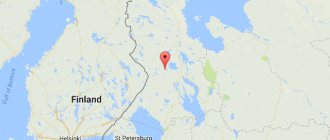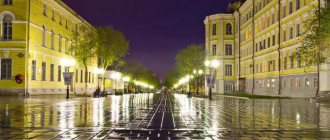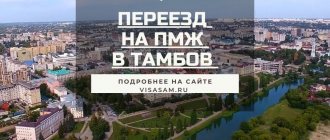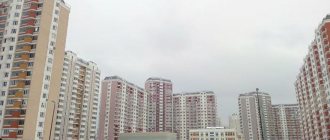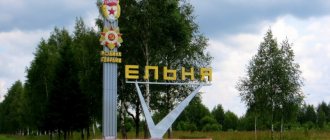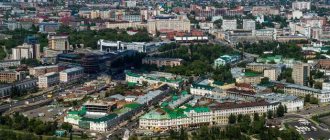There are many settlements in Russia with similar or identical names, most often these are small villages and hamlets. But there are also quite large administrative units with the same name, but different fates. For example, in our country there are two cities of Zheleznogorsk: one is located in the northwest near the city of Kursk, the other is in the northeast, 35 km from Krasnoyarsk.
History of Zheleznogorsk, Krasnoyarsk Territory
Until now, the city is an important strategic site and is considered a closed administrative unit. More than 50 years ago, disgraced scientists and engineers worked in these parts to create plutonium and other nuclear elements. Since 1985, a tunnel has been located here under 40 km of earth, where radioactive waste left over from uranium processing is stored. Although scientists claim low radiation contamination of the air in the region, isolated cases of harm to health occur from time to time.
The population of Zheleznogorsk still consists of scientists, workers, military personnel and their families. Entry into the city is carried out using special passes. Cars from other regions are allowed through only with special permission. The city exists thanks to Russia's largest chemical and mining plants, which serve the country's military and space sectors.
Geography
| Distance from Zheleznogorsk to the nearest major cities (by road)[7] | |||||||||
| St. Petersburg ~ 1129 km. Smolensk ~ 469 km. Bryansk ~ 226 km. | Moscow ~ 463 km. Kaluga ~ 299 km. | Tula ~ 283 km. Orel ~ 93 km. | |||||||
| Warsaw ~ 1060 km Berlin ~ 1639 km. | Lipetsk ~ 387 km. Voronezh ~ 341 km. | ||||||||
| Kyiv ~ 447 km. Odessa ~ 942 km. | Belgorod ~ 253 km. Kharkov ~ 329 km. Sevastopol ~ 1070 km. | Kursk ~ 110 km. Rostov-on-Don ~ 904 km. Sochi ~ 1465 km. | |||||||
Attractions
Despite the rather small population of Zheleznogorsk, less than 85 thousand people, the city has a widely developed cultural infrastructure. Thus, unique museums are opened here, where exhibits related to the mining and chemical industry are exhibited, as well as exhibitions that tell the story of the first workers, forced prisoners of the Gulag. Along with the mining museum, there is also an archaeological center where miners' finds are exhibited.
In addition to the Central City Library, small centers for reading enthusiasts are open in all districts. In 2010, Zheleznogorsk was even named the cultural capital of the Krasnoyarsk Territory.
Surprisingly, for 85 thousand people there are 4 theaters and 2 theater studios: the Operetta Theater, the Children's Puppet Theater, the Sovremennik Youth Theater and the People's Drama Theater named after. Ostrovsky.
Number, national composition
The population of Zheleznogorsk, Krasnoyarsk Territory, has changed little over the past 50 years. According to the 1979 census, 87 thousand people lived in the city. A small surge was observed in the mid-90s, when this figure reached 95-97 thousand people. But now, according to 2016 data, 84 thousand people live in Zheleznogorsk.
This consistency is due to the specifics of this area. This is not just a settlement, but a strategic zone with important objects of national importance. Enterprises require a certain number of workers, so there was no sharp decline in difficult years for the country. The population of Zheleznogorsk did not leave en masse for large centers, because there was stable work here too.
Sport
- Gornyak Stadium
- Yunost Stadium
- Swimming pool "Neptune" (Oktyabrskaya st., 44)
- Pool "Albatross"
- Sports complex OJSC "Gotek"
- Skating rink "Yubileiny"
- Sports and Wellness Complex “Start”
- Military sports club "BU-DO"
From 1999 to 2012, the Magnit football club took part in the third division of the Chernozemye zone of the Russian Football Championship. In November 2012, it was announced that the management of MGOK OJSC intended to use the funds allocated annually for the football team to other sports, which is due to the low number of fans at home matches. Because of this, FC Magnit refused to participate in third division matches.
The modern problem of employment
Today, the problem of finding a job even in such a seemingly prosperous city exists. The problem is the specific jobs that the city can provide, as well as the automation or even closure of some important infrastructure.
The Employment Center of Zheleznogorsk, Krasnoyarsk Region, like all similar institutions, is a state structure. It provides city residents with assistance in finding work, retraining opportunities and other services of a similar nature. Citizens can receive help completely free of charge.
The employment center of Zheleznogorsk, Krasnoyarsk Territory is located at 662971, Zheleznogorsk, Pionersky proezd, 6, post office box 32. Detailed information about existing vacancies can be found on the official website of the center. The list of jobs includes many offers for engineers in various fields, and salaries are higher than the national average. There is also a great demand for drivers, construction workers, finishers, support workers and doctors.
main feature
When designing the city, engineers tried to preserve the natural beauty of the taiga as much as possible. Therefore, the old and new quarters of Zheleznogorsk are designed in such a way that there is greenery everywhere. There are no frequent buildings here, as in other cities; if you look at the streets from the neighboring island, it seems that the houses are adjacent to the taiga.
In addition, next to residential areas on a hill there are ski slopes of different heights and distances. The city was designed by Leningrad engineers, and the park was originally planned without a lake. But local residents, on their own initiative, cleared the floodplain under the reservoir and built dams. Now there is a park with ancient trees and the pearl of Zheleznogorsk - a beautiful and clean pond.
Churches
- Church of All Saints who shone in the Russian land (Dachny Lane, 1a, tel.: (47148) 3-10-74, rector - Archpriest Alexey Kalashnikov, founded in 1989)
- Holy Trinity Church (rector - Priest Mikhail Yurochko)
- Temple of Xenia of St. Petersburg (in the Zheleznogorsk Veterans' House, Veteranov Ave., 10, rector - Priest Georgy Alekseenko)
- Parish of the Resurrection Church (Mira St., 55/5, rector - Archpriest Vladimir Terekhov)
- Church of the Resurrection of Christ (under construction)
- House church in honor of the Intercession of the Blessed Virgin Mary of the Zheleznogorsk diocesan administration (in the Matis complex)
- Temple-chapel in honor of the icon of the Mother of God “Vsetsaritsa” (Lenin St., 92/4, rector - Priest Sergei Matyshchuk)
- Temple in honor of the icon of the Mother of God “Supportress of Sinners” (Khutorskoy village, SMP, rector - Priest Konstantin Sokolov)
- Temple in honor of St. Sergius of Radonezh (trans. Avtolyubiteley, no. 7, under construction, rector - Svyatoslav Churkanov)
- Chapel in honor of St. Nicholas (Central Market)
- EX Church (Kominterna st., 11, pastor - Mikhail Vasilyevich Dudenkov)
- ECB Church "Revival" (next to the Zheleznogorsk Veterans' House, pastor - Alexander Stepanovich Khnychev)
- Church of the Council of Churches (Kurskaya St. 52)
See also: Zheleznogorsk diocese
History of Zheleznogorsk, Kursk region
Another city of the same name is located in the opposite part of Russia near Kursk. It is a populated area of regional significance. Like the previous city in the Krasnoyarsk Territory, Zheleznogorsk in the Kursk Region was founded in the 50s of the 20th century. The reason was the discovery of the Kursk magnetic anomaly, one of the largest and most powerful iron ore basins in the world. In 1962 it received its present name. Previously, the village was called Oktyabrsky.
Already in 1962, the population of Zheleznogorsk, Kursk region, amounted to more than 16 thousand people, and the village received the status of a city. It seems to be divided into two parts, in the western part there are mainly residential buildings and other urban infrastructure, and in the eastern part there are industrial facilities, railway tracks and other industrial zones. Neighboring small settlements have been included in the city district for several years now, and since 2010 they have been recognized as microdistricts of the regional center.
Attractions
The entire life of the population of Zheleznogorsk is connected with the extraction of iron ore raw materials. Mikhailovsky GOK is the largest enterprise not only in the region, but throughout Russia. More than 30% of the residents work here, and the entire budget is formed precisely at the expense of the industrial giant.
The city is small in size, but there are 8 schools and several gymnasiums, a central city library and smaller institutions of this kind are open. In addition, there are several dozen different clubs for the development of children, including the Young Naturalists Club, cultural clubs and Alice.
Zheleznogorsk is famous for its local history museum, as well as exhibitions related to the history of the development of the region. The city has several sports complexes, swimming pools, and military-patriotic clubs.
Education
- 8 secondary schools, 2 lyceums, 2 gymnasiums, 1 correctional school
- Zheleznogorsk Mining and Metallurgical College (former technical school)
- Zheleznogorsk Polytechnic College (formerly PU No. 16)
- Zheleznogorsk College of Service and Commerce (former PU No. 17)
- Zheleznogorsk Vocational School No. 18
- Zheleznogorsk Art College
- Zheleznogorsk branch of the Modern Humanitarian Academy
- Zheleznogorsk branch of Southwestern State University (Kursk)
- Zheleznogorsk branch of the Russian New University (RosNow)
- MOUDO "Zheleznogorsk Children's Art School"
- MOUDO "Children's Music and Choral School named after G. Struve."
- Municipal government institution of additional education “Station of Young Naturalists”
Number, national composition
Since 1959, there has been a constant increase in the city's population. For more than 50 years, virtually no demographic declines have been recorded. Today, together with the towns and villages included in the urban district, the population of Zheleznogorsk is slightly more than 100 thousand people.
This stable density is explained by the success of the city-forming enterprise. Local quarries still generate multimillion-dollar revenues. So residents do not need to leave in search of work in other regions.
Mostly Russians live in the city - more than 98%. In a smaller proportion here are Ukrainians, Jews, Armenians and Belarusians. Only Orthodox churches and temples are functioning.
mass media
Online publications:
- Information portal of the city of Zheleznogorsk https://zhel.city/
Printed publications:
- Weekly newspaper "Kursk Ore"
- Teleradio
- Radio "Iron FM"
- Weekly newspaper “Zheleznogorsk News”
- Weekly newspaper "Echo of the Week"
- Weekly newspaper of free advertisements “Making Choices”
- Weekly newspaper "City newspaper"
- Weekly newspaper “Zheleznogorsk Panorama”
- Weekly newspaper "Zhelezka"
Radio:
- 92.8 Humor FM
- 95.8 Love Radio
- 96.9 Traffic radio
- 98.6 Radio Dacha
- 99.0 Iron FM
- 100.2 Europe Plus
- 100.6 Radio 7 on Seven Hills
- 101.9 Radio Chanson
- 102.7 Autoradio
- 103.2 Russian radio
- 105.2 Radio Course
A television:
- 25 TVK - DVB-T2 digital (1mp)
- 27 TVK - DVB-T2 digital (2mp)
- TNT / TRC "Zheleznogorsk" Cable broadcasting
Job search problem
The employment center of Zheleznogorsk is located at the address: Kursk region, Zheleznogorsk, Gagarina street, 10a. The government agency provides citizens with a job search service. In case of insufficient qualifications, a person has the right to undergo free retraining or advanced training courses.
Today, the employment center of Zheleznogorsk, Kursk region, offers vacancies in technological professions - engineer, mechanic, electrician; in addition, managers of various levels are required - from administrators to directors.
Zheleznogorsk is an inexpensive and promising city in terms of accommodation. There are 20 industrial enterprises there, and specialists such as engineers, economists or geologists are always welcome here.
Population[ | ]
| Population | |||||||||||
| 1959[9] | 1967[10] | 1970[11] | 1976[10] | 1979[12] | 1986[10] | 1987[13] | 1989[14] | 1992[10] | 1996[10] | 1998[10] | 2001[10] |
| 1897 | ↗19 000 | ↗30 953 | ↗57 000 | ↗65 280 | ↗79 000 | ↗81 000 | ↗85 192 | ↗90 400 | ↗94 900 | ↗96 300 | ↗98 200 |
| 2002[15] | 2003[10] | 2005[10] | 2006[10] | 2007[10] | 2009[16] | 2010[17] | 2011[10] | 2012[18] | 2013[19] | 2014[20] | 2015[21] |
| ↘95 528 | ↘95 500 | ↗96 200 | ↗96 400 | ↗97 436 | ↗98 069 | ↘95 049 | →95 049 | ↗95 827 | ↗96 563 | ↗97 601 | ↗98 756 |
| 2016[22] | 2017[23] | 2018[24] | 2019[25] | 2020[26] | 2021[2] | ||||||
| ↗99 683 | ↗100 671 | ↗100 740 | ↘100 499 | ↘100 446 | ↗100 554 | ||||||
As of January 1, 2022, in terms of population, the city was in 202nd place out of 1116[27]cities of the Russian Federation[28].




